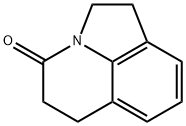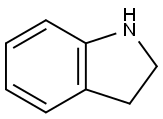Uses
Pyroquilon is used for the control of blast (Pyricularia oryzae) in
rice.
Definition
ChEBI: A pyrroloquinoline that is 1,2,5,6-tetrahydro-4H-pyrrolo[3,2,1-ij]quinoline in which the hydrogens at position 4 are replaced by an oxo group. A fungicide used to control rice blast, it is not approved wof use within the Eur
pean Union.
Metabolic pathway
The fate of pyroquilon in rice and rats has been reported. Given the metabolic
stability of cyclic amides, there are few options, other than hydroxylation,
open for the metabolism of the compound. Its biotransformation
involves initial hydroxylation at three sites in the molecule, followed by
ring-opening, dehydration and further oxidation affording a somewhat
complex picture. A study in rats revealed most of these metabolites
but with some further metabolic degradation. The usual differences in
conjugation were seen with mainly glucoside formation in plants and
glucuronide and sulfate formation in animals.
Metabolism
Animals: Rapidly metabolized and eliminated
via urine and feces. Residues in tissues were
generally low, and there was no evidence for accumulation
or retention of pyroquilon or its metabolites. Plants: Major
metabolites in rice grain were 3,4-dihydro-4-hydroxy-2-
oxoquinoline-8-acetic acid and two other acetic acid derivatives.
Soil/Environment: DT
50 (silty soil) 2, (sandy loam)
18 w. Kd 1.3–42 μg/g soil, little to moderately mobile.
Photolysis in water, DT
50 10 d.
Toxicity evaluation
Mammalian toxicology. Oral: Acute oral
LD
50 for rats 321, mice 581 mg/kg. Skin and eye:
Acute percutaneous LD
50 for rats >3100 mg/kg. Not
a skin irritant, minimal eye irritant (rabbits). Not a
skin sensitiser (guinea pigs). Inhalation LC50 (4 h) for
rats >5.1 mg/l air. NOEL: (2 yr) for rats 22.5, mice
1.5 mg/kg b.w. daily; (1 yr) for dogs 60.5 mg/kg b.w.
daily. ADI: 0.015mg/kg b.w. Other: Not teratogenic, not
mutagenic, not oncogenic. Toxicity class: WHO (a.i.) II;
EPA (formulation) II RC risk R22. Ecotoxicology. Birds:
LC50 (8 d) for Japanese quail 794, chickens 431 mg/kg.
LC50 (8 d) for Japanese quail >10000 mg/kg. Fish LC50
(96 h) for catfish 21, rainbow trout 13, perch 20, guppy
30 mg/l. Bees: Practically nontoxic to honeybees; LD
50
(oral) > 20, (contact) > 1000 mg/bee. Daphnia LC50 (48 h)
> 60 mg/L. Algae: No effect on Scenedemus acutus.
Degradation
Pyroquilon is stable to hydrolysis over a very wide pH range. It is
degraded under conditions of aqueous photolysis with a DT
50 of 10 days
(PM). Details are not available.




